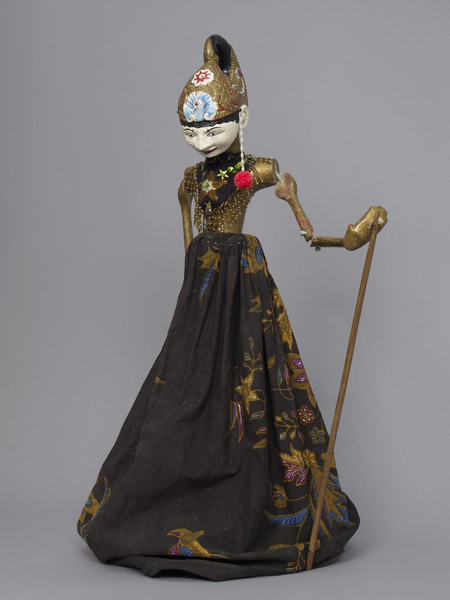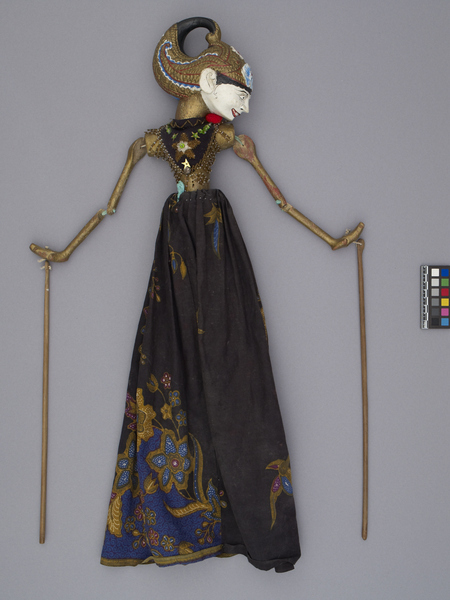Rod Puppet Item Number: 2872/30 a-e from the MOA: University of British Columbia



Description
Rod puppet (wayang golek) of a god character, Batara Kamajaya. The puppet has a white face with finely painted features and red smiling lips slightly parted. On his head is a large headdress, curved above the head at the back, painted gold. In front of the ear on the left side is a hanging pink pompom. A black velvet bib hangs around the neck and covers the torso, and is decorated with sequence and beads. At the waist sits a long sarong, tied with green twine. Below the sarong is a wooden stick that extends up through the torso and into the puppet’s head to control its movement. The puppet’s arms are moveable at shoulder and elbow by wooden sticks attached to each hand. The elbow joints are tied with green twine. The parts of the puppet are (a) head, (b) body, (c) arm stick, (d) torso stick, (e) stand. The arm stick for the right hand has become detached.
History Of Use
Javanese puppetry as an art form probably developed by the 11th century. The three-dimensional wooden wayang golek puppets of western Java, which are to be distinguished from the earlier and more sacred wayang kulit shadow plays puppets or other forms, appeared during the 16th century. Originally the plays depicted Javanese mythology, but after the Indian conquest of Java the Hindu epics, Ramayana and Mahabharata, were incorporated into the cycles, which comprise about 200 plays. An individual or group hires a dalang (puppet-master) to celebrate important occasions. The performances often last all night and are generally presented in three acts, with vocal and instrumental accompaniment. The individual plays vary widely in detail but usually involve conflict between good and evil. They serve a moral and religious purpose, and more recently, one of political commentary. Each puppet's character is represented by its appearance and placement on stage; protagonists with strong elements of good are placed to the right, antagonists of violent or evil nature to the left. This depicts the character Kamajaya, the god of love, who married Dewi Ratih, a goddess.
Iconographic Meaning
Represents Kamajaya, the god of love; a refined (alus) white-faced figure, wearing a 'shrimp-tail' headdress.
Item History
- Made in West Java, Indonesia
- Collected between 1990 and 1999
- Owned by Betty Cairney
- Owned by Jack Cairney before March 15, 2011
- Received from Jack Cairney (Donor) on March 15, 2011
What
Who
- Culture
- Sundanese
- Previous Owner
- Betty Cairney and Jack Cairney
- Received from
- Jack Cairney (Donor)
Where
- Holding Institution
- MOA: University of British Columbia
- Made in
- West Java, Indonesia
When
- Collection Date
- between 1990 and 1999
- Ownership Date
- before March 15, 2011
- Acquisition Date
- on March 15, 2011
Other
- Condition
- fair
- Accession Number
- 2872/0030 a-e